Description of the Senshui onion variety, planting and care features
Senshui is one of the most popular winter onion varieties. Bred in Japan, it quickly attracted the attention of gardeners in many countries, since it is unpretentious in maintenance, has a high yield and a pleasant taste. What needs to be considered when growing in order to get a decent harvest?
The content of the article
Senshui variety description
The variety is characterized by a round-oval shape of the bulbs, lack of pungency in taste and a pronounced aroma. Senshui is suitable for fresh consumption and as an additive in various preserves.
The variety is the result of the work of Japanese breeders. It was withdrawn in the 1970s.
Chemical composition, trace elements and vitamins, useful properties
The onion contains: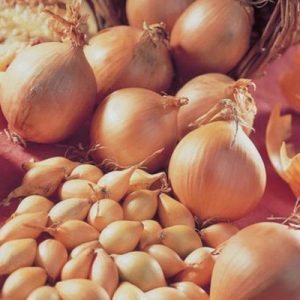
- phytoncides;
- minerals - calcium, magnesium, iron, phosphorus, etc .;
- vitamins A, B1, B2, C, PP;
- essential oil with sulfur-containing formations;
- proteins;
- Sahara;
- mineral salts.
Onions help remove cholesterol from the body, help prevent cancer, fight bacteria, and have anti-inflammatory properties.
Ripening period and yield
Senshui is an early ripening onion variety. Feathers reach technical maturity in early spring, bulbs in mid-summer.
Provided proper planting and compliance with the rules of care, the yield is 4 kg per 1 m².
Disease resistance
The variety is immune to common diseases typical of this crop. It is especially resistant to powdery mildew. However, there is a risk of damage to plants by pests, therefore, preventive measures must be taken in a timely manner.
Characteristics of the bulb, description of the appearance, taste
Wide leaves-feathers of dark green color reach 50 cm in height. Bulbs of a rounded, slightly flattened shape weigh an average of 160-180 g, but with proper agricultural technology, their weight reaches 250 g. Husks are bright yellow with a golden tint.
The pulp is white, juicy, crispy and aromatic, has a soft, sweet taste without pronounced pungency.
Growing regions and climate requirements
The variety is recommended for cultivation in the southern regions. Well adapted to the climatic conditions of central Russia.
Advantages and disadvantages of the variety
The main advantages of the Senshui variety: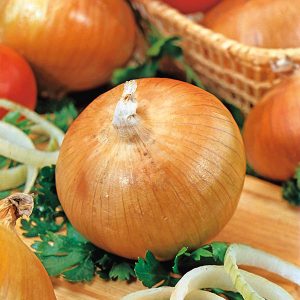
- early maturation;
- frost resistance;
- high yield for a winter variety;
- versatility of use;
- the possibility of long-term storage;
- lack of shooting;
- unpretentious care.
Minuses:
- not suitable for growing as winter onions in northern regions with consistently low air temperatures;
- lower, in comparison with spring varieties, productivity.
Differences from other varieties
Comparison of Senshui with other varieties of winter onions is presented in the table:
| Variety | Productivity, kg / m2 | Bulb shape | Taste | Bulb weight, g |
| Senshui | 4 | Rounded, slightly flattened | Sweetish | 160-180 |
| Radar | 7-8 | Round | Sweet spicy | 150-300 |
| Shakespeare | 3,5 | Rounded | Semi-sharp | 100-250 |
| Centurion | 4-5 | Slightly elongated | Spicy, spicy | 90-130 |
Features of planting and growing
Winter onions have special planting requirements, strict adherence to which allows you to get a high-quality harvest.
Presowing preparation
Onions are a biennial crop. Seeds collected from arrows are only suitable for growing Senshui onion sets. The next year, it is used to obtain a full harvest.
Sevka varieties:
- wild oat - no more than 1 cm;
- the first category - 1-1.5 cm;
- the second category - 1.5-3 cm;
- sample - from 3 cm in diameter.
There is no need for preliminary preparation of the planting material (soaking, pruning), however, it is important to ensure that there is no rot or damage on the surface of the seedlings.
Reference. The largest heads of onions grow from wild oats, and large sets produce juicy greens early.
Prepare the soil about 14 days before planting the onions. The soil is carefully dug up and organic (rotted mullein or bird droppings) and complex mineral fertilizers are applied. After that, the beds are left so that the soil settles a little.
Immediately before planting the onion, the beds are sprinkled with wood ash and ridges about 20 cm high are formed.
Ground requirements
The soil should be fertile, moderately loose and have neutral acidity. Too heavy soil prevents germination, and increased acidity leads to rotting of unripe bulbs.
Timing, scheme and landing rules
The timing depends on the climatic conditions of the growing region. It is necessary to finish planting the onions before the frost. In the southern regions, it is recommended to plant onions in November, and in the northern regions, in September or October.
Important! At the time of planting onions, the soil temperature at a depth of 10-15 cm should be + 5 ° C.
Landing scheme:
- In prepared beds, make grooves with a maximum depth of 5 cm, the distance between them is 15-20 cm.
- Place the seedlings along the furrows, deepening by 2 cm and maintaining a distance of about 15 cm between the bulbs.
- Cover the sevok with earth and humus.
- Insulate the beds with a layer of spruce branches or sawdust.
Covering material is removed in early spring so that it does not interfere with the germination of plants.
Growing features
When growing yellow onions, it is necessary to follow the rules of crop rotation: beets, carrots, cabbage and greens are considered the best predecessors. In an area where legumes, bulbs and potatoes used to grow, this variety can be planted after five years.
The place for planting onions should be well-lit, protected from the wind and located on a hill - the variety does not develop well in the shade, and moisture accumulates in the lowlands, which is why the bulbs prey.
Senshui is an unpretentious variety... The main care for him is carried out at the beginning of spring and practically does not differ from the care for other varieties of onions.
Watering mode
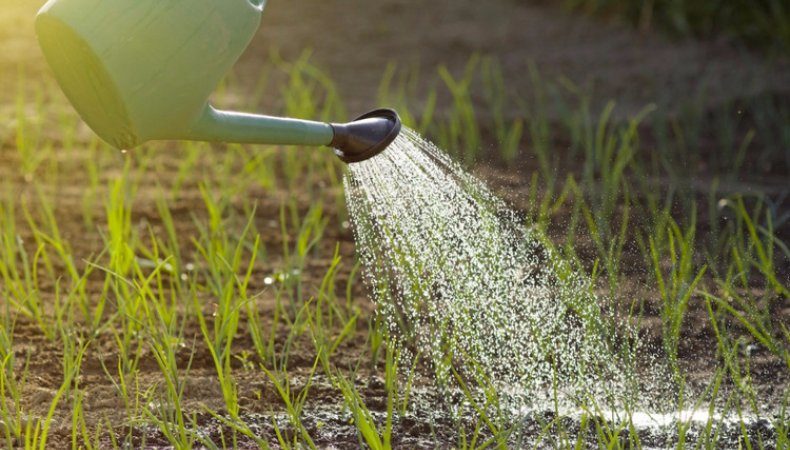
This variety does not need abundant watering... They begin to moisten the earth no earlier than May and only as necessary, preventing the topsoil from completely drying out.
Watering is stopped 2-2.5 weeks before harvesting so that the bulbs gain maximum weight, and the husks have time to dry out.
Loosening the soil and weeding
The soil in the aisles is regularly weeded, getting rid of weeds that impede the development and growth of onions.
The soil is loosened after each watering - this makes it lighter, promotes better penetration of moisture and air to the roots of plants and prevents the formation of a crust on the surface of the earth.
Top dressing
In the spring, when stable warm weather is established, covering material is removed from the beds, urea (10 g per 1 m²) is added to the soil, the soil is loosened and sprinkled with wood ash.
When 4 leaves appear on the plants, fertilizing is carried out with phosphorus (20 g per 1 m²) and potash (10 g per 1 m²) fertilizers.
Important! The best way to apply top dressing is to water the onion with liquid fertilizers.
Disease and pest control
To prevent the development of diseases and pest attacks, the beds are treated with agents against tobacco thrips, nematode, onion flies ("Aktara", "Medvedoks"), dusted with tobacco dust, hot red pepper, sprayed with infusion of marigolds, alkaloid lupine.
Growing difficulties
When growing the Senshui winter bow, you may encounter the following problems: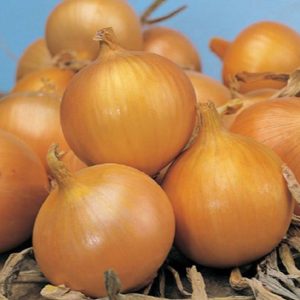
- damage to planting material in case of planting seedlings in frozen ground;
- premature germination when planting too early;
- decay of bulbs due to over-watering or planting in the ground with high acidity;
- an increase in the risk of developing diseases and insect attacks in case of non-compliance with the rules of crop rotation.
Harvesting and storage
Harvesting begins when yellowness appears on the onion feathers. It is important to have time before complete yellowing, otherwise, after the first rain, new roots will begin to form.
Depending on the climate of the region, the crop is harvested in June or July, gently pulling the bulbs out of the ground.
Storage features and keeping quality of the variety
The collected bulbs are laid out on the ground under the sun for 7-10 days for drying and disinfection, and then they are kept under a canopy for another 20 days. This contributes to better storage of the crop.
Reference. In rainy weather, onions are dried in a closed, well-ventilated area.
After drying, the onions are examined and sorted out: the heads, which have some damage, are set aside for the soonest use, and the whole are removed for storage, after cutting off the roots and feathers from them at a height of 5 cm from the neck.
Store Senshui in nets, baskets or drawers with ventilation holes in a cool, dark room. On average, without loss of quality, the crop is stored for 3-4 months, maximum - six months.
Tips from experienced gardeners
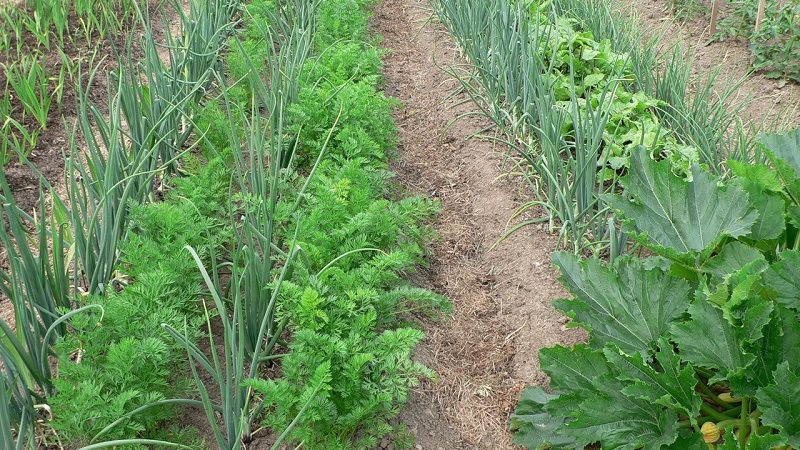
Farmer Recommendations for Cultivating the Senshui:
- Plant marigolds around the onion beds to minimize the risk of pest attacks.
- Try to plant carrots nearby - they scare away onion flies.
- Watch out for watering - this variety tolerates short-term drought better than excessive moisture.
- Before applying top dressing, dilute fertilizers in water, or better - in herbal infusion.
Reviews
The Senshui bow is loved by farmers, which is confirmed by their numerous positive reviews.
Evgeniya, Novorossiysk: «At first we planted Senshui only for ourselves, but for more than 5 years we have been growing it for sale. We started with a small amount and gradually increase the planting - the onions taste great, they are sold out instantly. Only one minus was noted - like other winter varieties, Senshui strongly attracts pests, so the plantings must be carefully inspected and preventive treatment should not be neglected.
Dmitry, Astrakhan: “Three years ago I read the description of the Senshui onion variety and looked at the photos on the Internet. We decided to plant it and immediately fell in love with this variety for its taste. It is not very bitter, even children are happy to eat it fresh. The variety is stored well - for sure until January. Previously, problems were with onion flies, they did not already know how to deal with them, but then they read that marigolds frighten them off. We planted them around the beds, and the insects were almost gone. "
Conclusion
Senshui is an early ripening winter onion suitable for growing in small backyards and farms. The variety is resistant to frost and most diseases, adapted to the climate of the middle zone and has a mild, not pungent taste.